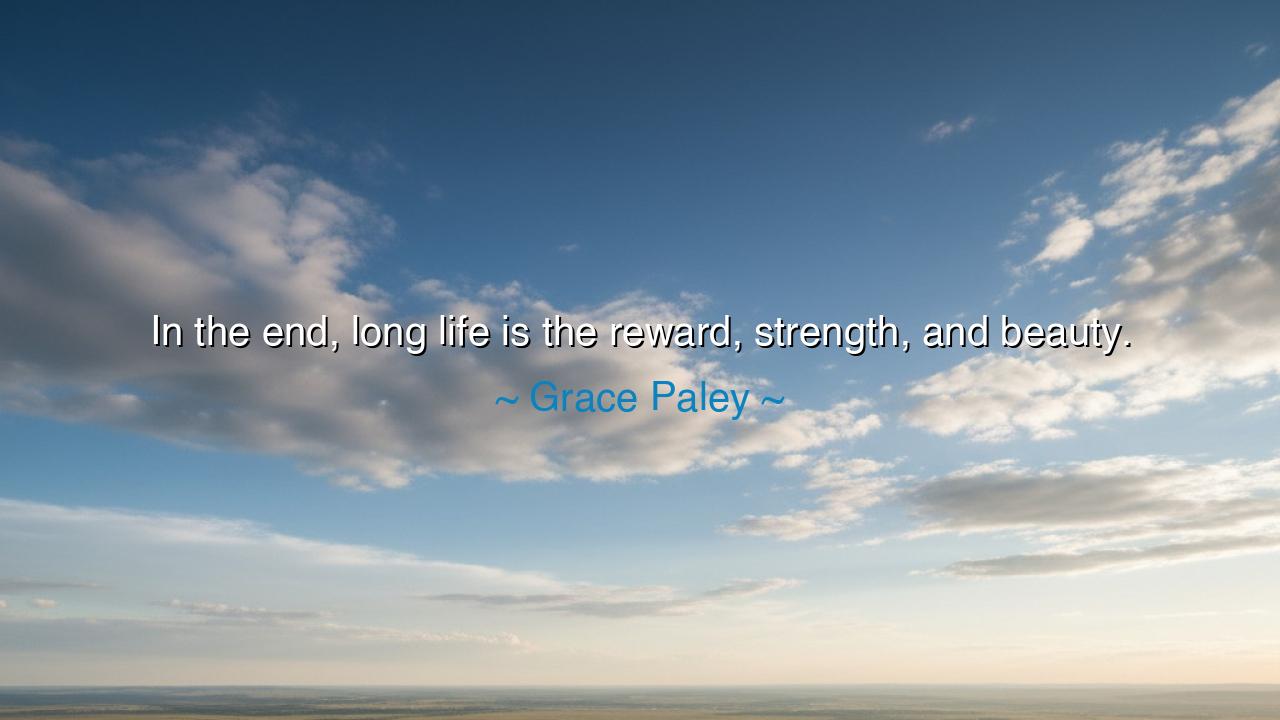
In the end, long life is the reward, strength, and beauty.






The words of Grace Paley resound with the solemn calm of a bell tolling at dusk: “In the end, long life is the reward, strength, and beauty.” They carry the wisdom of one who has seen the turning of many seasons, and who knows that the true measure of living is not in its swiftness or in its glittering peaks, but in its endurance, in its steady unfolding across years. To live long is not merely to survive; it is to reap the harvest of endurance, to witness the threads of time weaving their pattern, to hold in one’s body and spirit the quiet majesty of resilience.
Paley, a writer and activist, lived her life among the struggles and triumphs of her community. She knew that life was not always gentle, and that many souls are struck down too early. Thus, when she speaks of long life as a reward, she is not speaking of luxury or ease, but of the deep gift of being allowed to remain, to keep watching, to keep creating, to keep loving. Each additional year is a crown upon the head of endurance, a testament that one has walked through storms and yet still stands.
The ancients too honored this truth. In many cultures, the elders were seen as the keepers of wisdom, not because they read more books, but because they had lived more days. The Greeks told of Nestor, the aged warrior of the Iliad, whose long years made him not weaker, but a source of counsel and perspective. The Hebrews spoke of Moses, who lived to see a hundred and twenty years, and whose eyes, the Scripture says, “were not dim, nor his natural force abated.” In their age, they embodied the strength that comes not from muscles alone, but from a life tested and tempered by time.
And let us not forget the example of Nelson Mandela. He endured twenty-seven years of imprisonment, yet was given the grace of long life to see freedom, reconciliation, and the dawn of a new South Africa. His age did not diminish him but adorned him, his silver hair becoming a symbol of a people’s endurance. In him we see the beauty that Paley names—the beauty of long life as a vessel for justice, for wisdom, for hope fulfilled.
The meaning of the quote is not to glorify mere longevity, but to show that when life stretches long, it brings with it treasures that youth cannot hold. The reward is memory, the ability to look back and see how the threads of suffering and joy wove a single tapestry. The strength is resilience, for the one who has lived long has faced grief and risen again, has endured loss and yet chosen love once more. The beauty is perspective, the serenity that comes when one sees life not in fragments but in wholeness.
The lesson for us is this: do not measure life only by the passions of youth or the achievements of the moment. Remember that each day endured adds to your store of wisdom, each year endured deepens your strength. Honor your elders, for their long lives are not just survival but living libraries of courage. And honor your own days, treating them as the sacred building blocks of a future in which you too may sit with the crown of years and speak with the weight of time behind your words.
Practical action lies in living not for haste but for endurance. Care for your body so it may carry you long; nourish your spirit so it does not wither; live in kindness so that age will find you surrounded by love, not loneliness. And when you meet trial, do not despise it—for every storm endured lengthens the story of your life, bringing you closer to the reward of long years.
So let Grace Paley’s words remain with us: in the end, long life itself is the reward, the strength, the beauty. It is the quiet crown placed upon the head of the one who has endured, who has loved, who has risen each day to meet the sun. And in that crown lies the proof that the soul, tempered by time, can shine with a radiance greater than youth’s fire, a radiance born of endurance, patience, and the eternal gift of life prolonged.






AAdministratorAdministrator
Welcome, honored guests. Please leave a comment, we will respond soon